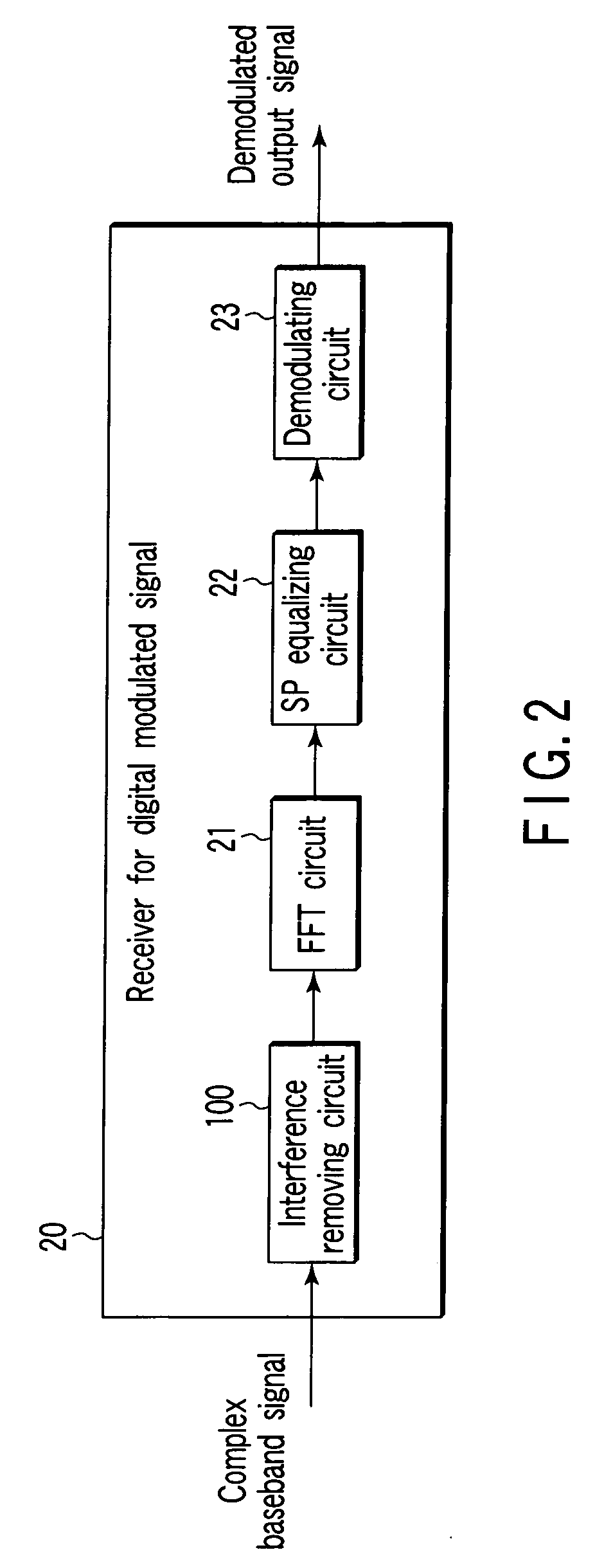Receiver for digital modulated signal and receiving method for the same
a technology of digital modulation and receiving method, which is applied in the direction of digital transmission, baseband system, electrical apparatus, etc., can solve the problems of deteriorating reception performance, multi-path interference having such a long delay time, and extremely deteriorating reception performan
- Summary
- Abstract
- Description
- Claims
- Application Information
AI Technical Summary
Benefits of technology
Problems solved by technology
Method used
Image
Examples
first embodiment
[0024] Referring to FIG. 1 to FIG. 4, FIG. 9 and FIG. 10, a first embodiment will be described.
[0025] A first embodiment relates to an Integrated services digital broadcasting for terrestrial (ISDB-T) (other embodiments go the same). In the following explanations, it is presumed that a scattered pilot (hereinafter referred to as SP) carrier that is an amplitude / phase reference is used as a reference signal in estimating a transmission path response.
[0026] The ISI and the ICI will be explained by referring to FIG. 9 and FIG. 10. FIG. 9 shows one transmission symbol of an OFDM. Because a signal component of a guard interval is the same as that of a rear section of an effective symbol, signal components belonging to the guard interval and to the rear section of the effective symbol are indicated, as shown in FIG. 9, as “A” and signal components belonging to other sections are indicated as “B” for simplifying the explanation. To express clearly the fact that the polarities of the sign...
second embodiment
[0069] Referring next to FIG. 5 and FIG. 6, a second embodiment will be set forth.
[0070] In particular, another embodiment in which a generation method and a combining method for a replica signal have been changed will be explained. The second embodiment is featured by firstly obtaining the difference between a signal resulting from delaying the receiving wave by the effective symbol period and the receiving wave, then, generates the replica signal on the basis of the difference signal. The case in which the interference removing circuit of the second embodiment appropriately selects the result of combination of the receiving wave and the replica signal over the whole period and the receiving wave to output it is also exemplified.
[0071]FIG. 5 is the block diagram showing the configuration of the interference removing circuit in the second embodiment. The removing circuit is applied to the receiver for the digital modulated signal 20.
[0072] The removing circuit 100 comprises the s...
third embodiment
[0085] In succession, a third embodiment will be described by referring to FIG. 7 and FIG. 8.
[0086] Other embodiment varying the generation method and combining method for the replica signal will be described. The third embodiment is featured by setting a signal cut-out unit in front of a reflected wave component generation unit. Such a configuration enables the delay time detection circuit to be omitted.
[0087]FIG. 7 is the block diagram showing the configuration of the interference removing circuit 100 in the third embodiment. The removing circuit 100 is applied to the receiver for the digital modulated signal 20 shown in FIG. 2.
[0088] The removing circuit 100 comprises the symbol position detector 150 detecting the breaks of the transmission symbol from the input signal, an inter-symbol difference generation circuit 570 outputting the difference (inter-symbol difference signal) between the input signal and a signal resulting from delaying the input signal by the time of the eff...
PUM
 Login to View More
Login to View More Abstract
Description
Claims
Application Information
 Login to View More
Login to View More - R&D
- Intellectual Property
- Life Sciences
- Materials
- Tech Scout
- Unparalleled Data Quality
- Higher Quality Content
- 60% Fewer Hallucinations
Browse by: Latest US Patents, China's latest patents, Technical Efficacy Thesaurus, Application Domain, Technology Topic, Popular Technical Reports.
© 2025 PatSnap. All rights reserved.Legal|Privacy policy|Modern Slavery Act Transparency Statement|Sitemap|About US| Contact US: help@patsnap.com



